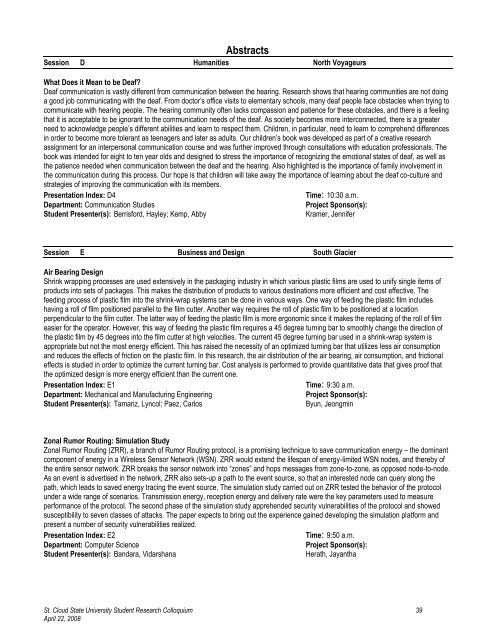2008 Proceedings - St. Cloud State University
2008 Proceedings - St. Cloud State University
2008 Proceedings - St. Cloud State University
Create successful ePaper yourself
Turn your PDF publications into a flip-book with our unique Google optimized e-Paper software.
Abstracts<br />
Session D Humanities North Voyageurs<br />
What Does it Mean to be Deaf?<br />
Deaf communication is vastly different from communication between the hearing. Research shows that hearing communities are not doing<br />
a good job communicating with the deaf. From doctor‘s office visits to elementary schools, many deaf people face obstacles when trying to<br />
communicate with hearing people. The hearing community often lacks compassion and patience for these obstacles, and there is a feeling<br />
that it is acceptable to be ignorant to the communication needs of the deaf. As society becomes more interconnected, there is a greater<br />
need to acknowledge people‘s different abilities and learn to respect them. Children, in particular, need to learn to comprehend differences<br />
in order to become more tolerant as teenagers and later as adults. Our children‘s book was developed as part of a creative research<br />
assignment for an interpersonal communication course and was further improved through consultations with education professionals. The<br />
book was intended for eight to ten year olds and designed to stress the importance of recognizing the emotional states of deaf, as well as<br />
the patience needed when communication between the deaf and the hearing. Also highlighted is the importance of family involvement in<br />
the communication during this process. Our hope is that children will take away the importance of learning about the deaf co-culture and<br />
strategies of improving the communication with its members.<br />
Presentation Index: D4<br />
Time: 10:30 a.m.<br />
Department: Communication <strong>St</strong>udies<br />
Project Sponsor(s):<br />
<strong>St</strong>udent Presenter(s): Berrisford, Hayley; Kemp, Abby<br />
Kramer, Jennifer<br />
Session E Business and Design South Glacier<br />
Air Bearing Design<br />
Shrink wrapping processes are used extensively in the packaging industry in which various plastic films are used to unify single items of<br />
products into sets of packages. This makes the distribution of products to various destinations more efficient and cost effective. The<br />
feeding process of plastic film into the shrink-wrap systems can be done in various ways. One way of feeding the plastic film includes<br />
having a roll of film positioned parallel to the film cutter. Another way requires the roll of plastic film to be positioned at a location<br />
perpendicular to the film cutter. The latter way of feeding the plastic film is more ergonomic since it makes the replacing of the roll of film<br />
easier for the operator. However, this way of feeding the plastic film requires a 45 degree turning bar to smoothly change the direction of<br />
the plastic film by 45 degrees into the film cutter at high velocities. The current 45 degree turning bar used in a shrink-wrap system is<br />
appropriate but not the most energy efficient. This has raised the necessity of an optimized turning bar that utilizes less air consumption<br />
and reduces the effects of friction on the plastic film. In this research, the air distribution of the air bearing, air consumption, and frictional<br />
effects is studied in order to optimize the current turning bar. Cost analysis is performed to provide quantitative data that gives proof that<br />
the optimized design is more energy efficient than the current one.<br />
Presentation Index: E1<br />
Time: 9:30 a.m.<br />
Department: Mechanical and Manufacturing Engineering<br />
Project Sponsor(s):<br />
<strong>St</strong>udent Presenter(s): Tamariz, Lyncol; Paez, Carlos<br />
Byun, Jeongmin<br />
Zonal Rumor Routing: Simulation <strong>St</strong>udy<br />
Zonal Rumor Routing (ZRR), a branch of Rumor Routing protocol, is a promising technique to save communication energy – the dominant<br />
component of energy in a Wireless Sensor Network (WSN). ZRR would extend the lifespan of energy-limited WSN nodes, and thereby of<br />
the entire sensor network. ZRR breaks the sensor network into ―zones‖ and hops messages from zone-to-zone, as opposed node-to-node.<br />
As an event is advertised in the network, ZRR also sets-up a path to the event source, so that an interested node can query along the<br />
path, which leads to saved energy tracing the event source. The simulation study carried out on ZRR tested the behavior of the protocol<br />
under a wide range of scenarios. Transmission energy, reception energy and delivery rate were the key parameters used to measure<br />
performance of the protocol. The second phase of the simulation study apprehended security vulnerabilities of the protocol and showed<br />
susceptibility to seven classes of attacks. The paper expects to bring out the experience gained developing the simulation platform and<br />
present a number of security vulnerabilities realized.<br />
Presentation Index: E2<br />
Time: 9:50 a.m.<br />
Department: Computer Science<br />
Project Sponsor(s):<br />
<strong>St</strong>udent Presenter(s): Bandara, Vidarshana<br />
Herath, Jayantha<br />
<strong>St</strong>. <strong>Cloud</strong> <strong>St</strong>ate <strong>University</strong> <strong>St</strong>udent Research Colloquium 39<br />
April 22, <strong>2008</strong>
















